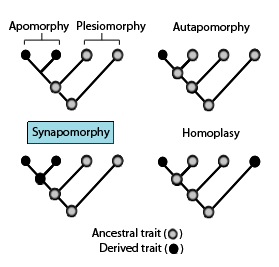
Back Sinapomorfia AN تواسم مشتق وتواسم مشتق متماثل Arabic Sinapomorfia Catalan Apomorphie#Unterteilung von Apomorphien German Sinapomorfio Esperanto Sinapomorfia Spanish Sünapomorf Estonian جداریختی Persian Synapomorphie French Sionapamorf Irish

In phylogenetics, an apomorphy (or derived trait) is a novel character or character state that has evolved from its ancestral form (or plesiomorphy).[2][3][4] A synapomorphy is an apomorphy shared by two or more taxa and is therefore hypothesized to have evolved in their most recent common ancestor.[1][5][3][6][7][8][9] In cladistics, synapomorphy implies homology.[5]
Examples of apomorphy are the presence of erect gait, fur, the evolution of three middle ear bones, and mammary glands in mammals but not in other vertebrate animals such as amphibians or reptiles, which have retained their ancestral traits of a sprawling gait and lack of fur.[10] Thus, these derived traits are also synapomorphies of mammals in general as they are not shared by other vertebrate animals.[10]
- ^ a b Roderick D.M. Page; Edward C. Holmes (14 July 2009). Molecular Evolution: A Phylogenetic Approach. John Wiley & Sons. ISBN 978-1-4443-1336-9.
- ^ Futuyma, Douglas J.; Kirkpatrick, Mark (2017). "Tree of life". Evolution (4th ed.). Sunderland, Mass.: Sinauer Associates. pp. 27–53.
- ^ a b Futuyma, Douglas J.; Kirkpatrick, Mark (2017). "Phylogeny: The unity and diversity of life". Evolution (4th ed.). Sunderland, Mass.: Sinauer Associates. pp. 401–429.
- ^ "Reconstructing trees: Cladistics". Understanding Evolution. University of California Museum of Paleontology. 5 May 2021. Retrieved 16 October 2021.
- ^ a b Kitching, Ian J.; Forey, Peter L.; Williams, David M. (2001). "Cladistics". In Levin, Simon A. (ed.). Encyclopedia of Biodiversity (2nd ed.). Elsevier. pp. 33–45. doi:10.1016/B978-0-12-384719-5.00022-8. ISBN 9780123847201. Retrieved 29 August 2021.)
- ^ Hillis, David M.; Sadava, David; Hill, Richard W.; Price, Mary V. (2014). "Reconstructing and using phylogenies". Principles of Life (2nd ed.). Sunderland, Mass.: Sinauer Associates. pp. 325–342. ISBN 978-1464175121.
- ^ Currie PJ, Padia K (1997). Encyclopedia of Dinosaurs. Elsevier. p. 543. ISBN 978-0-08-049474-6.
- ^ Concise Encyclopedia Biology. Tubingen, DEU: Walter de Gruyter. 1996. p. 366. ISBN 9783110106619.
- ^ Barton N, Briggs D, Eisen J, Goldstein D, Patel N (2007). "Phylogenetic Reconstruction". Evolution. Cold Spring Harbor Laboratory Press.
- ^ a b Baum, David (2008). "Trait Evolution on a Phylogenetic Tree: Relatedness, Similarity, and the Myth of Evolutionary Advancement". Nature Education. 1 (1): 191.
© MMXXIII Rich X Search. We shall prevail. All rights reserved. Rich X Search